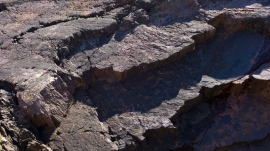The rocks on the islands Leka and Vega and the mountain Torghatten belong to the three main types:
1 Magmatic rocks
2 Sedimentary rocks
3 Metamorphic rocks
Magmatic rocks (igneous rocks)
As the name implies, the magmatic rocks originates from a melt-magma deep down in the crust and forms by cooling and solidification. In this context Leka is unique, with so many types of magmatic rocks and even with rocks of mantle-origin. The magmatic rocks is divided into three subgroups on the basis of the formation. Within each of these groups the rocks are further classified according to mineral content.
Intrusive (plutonic) rocks forms deep within the earth’s crust where large chambers with liquid melt slowly solidifies into stone, and develops crystals that are visible to the eye. The most common intrusive igneous rock from the continental crust is granite, and from the oceanic crust gabbro.
Hypabyssal rocks forms above the intrusive rocks, but below the surface into sills and dykes, and more rapid crytstallization developes smaller crystals than of intrusive rocks.
Extrusive rocks is formed from lava that has erupted to the surface by volcanic activity and rapidly solidified to rocks, normally on continents or along mid-oceanic ridges on the sea floor. A rock of oceanic origin is dark, containing a high percentage of dark, heavy minerals as pyroxene, and is called a basalt. A rocks of continental origin, as rhyolite, is lighter, and contains a higher percentage of lighter and slighter minerals as quartz and feldspar.
On Leka, it is also found a type of rock that is very rare, namely solidified mantle, from the zone below oceanic crust. For rock- enthusiasts, so-called hard-rockers, it is worth to mention that this rock is a variant of peridotite, a so-called harzburgite, with a higher specific gravity than oceanic crust, containing mainly the minerals olivine and enstatite, a pyroxene-mineral. They both have a specific gravity of c. 3.3, considerable higher than the 2.65 of quartz. These ratios of density are compared to water with a normal ratio of 1.0. An idealized section of oceanic crust and uppermost mantel is found here.
Click on the photos for enlargements.
Figure 1: Photo of a typical granite, with visible light colored mineral grains (feldspar and quartz) and without structures. The close-up photo is of a boulder from Leka.
Figure 2: The rock-surface of peridotite on Leka is normally weathered to yellowish grey, while the unweathered rock a cm below the surface is dark.
Figure 3: The photo is taken of two types of peridotite, to the left a dunite, and to the right harztburgite, which has a much more rugged surface and denser layered structure. Between the two rocks is the moho-discontinuity, seen as a line.
Sedimentary rocks
Sedimentary rocks are formed by erosion, transport, deposition, and consolidation of sediments. The consolidation is a rather slow process where particles are pressed against each other under high pressure, causing cementation by the creation of new minerals as quartz in the contact-zone. The process is called diagenesis).
The sizes of grains depends on processes. At a glacier, grains are formed by two main processes, frost-weathering and scouring. The first involves plucking of rocks when water freezes and expands in rock fractures while the other involves rock polishing (abrasion) by glacial movement beneath the ice, where sediments frozen to the sole of the glacier abrades the rock beneath. As a consequence a typical till, the sediments of a glacier, contains all grain-sizes. The rock equivalent is named a tillite. The oldest tillite in the world is found in East Finnmark (Bigganjarga), formed in the end of Precambrium. The river, the wind, or the waves are not capable of transporting the coarsest grain-fractions over distances, and the finest grains are deposited under more tranquil conditions. Typical sediments and sedimentary rocks from these environments usually consists of layered cobble, pebble, and sand. A common feature of sedimentary rocks is that you often see layering, formed during deposition. Sometimes layering is not visible, as in till/tillite.
Figure 4: The greyish rocks northeast of Leka has no visible layering, but is nevertheless a typical sandstone, probably deposited at or just outside a beach. Although you can’t see it, it is probably airspace between the grains of which the rock is made up of. Sandstones are therefore common reservoir rocks, storing oil and gas, as below seabed in the North Sea and Norwegian Sea.

Figure 5: The photo shows a conglomerate, which is typically composed of pebble in a finer matrix. It’s origin may have been an ancient beach or river.
Metamorphic rocks
Rocks and sediments can, when pressure and temperature beneath the surface is high enough, be transformed to a new rock, with other minerals and structures. New minerals tend to form in distinct layers or zones (called foliation). Some metamorphic rocks, as slate and shales from oceanic clay, and greenstone, from basalts or gabbro, are formed by moderate temperature and pressure increase. In a schist, a medium-grade metamorphic rock, mica is formed in thin zones, in which the rocks tends to cleave along parallel planes, due to weak chemical bondings between the different flakes of platy micas as muskovite and biotite. High grade metamorphic rocks, such as gneiss, are formed under high pressure and temperature. In gneiss segregation of light and dark minerals gives the rock a gneissic structure. Due to small amount of mica gneiss is normally resistant to weathering.

Figure 6: Photo of a red colored shale. The color of the rock is caused by the influence of the surrounding volcanism that occurred during sedimentation, prior to the later metamorphosis.
Figure 7: The photo shows a green coloured boulder northeast of Leka, with visible stratification. It is a typical greenschist, metamorphosed from olivine-rich oceanic crust or mantle.
Figure 8: The photo shows a boulder of typical gneiss.






